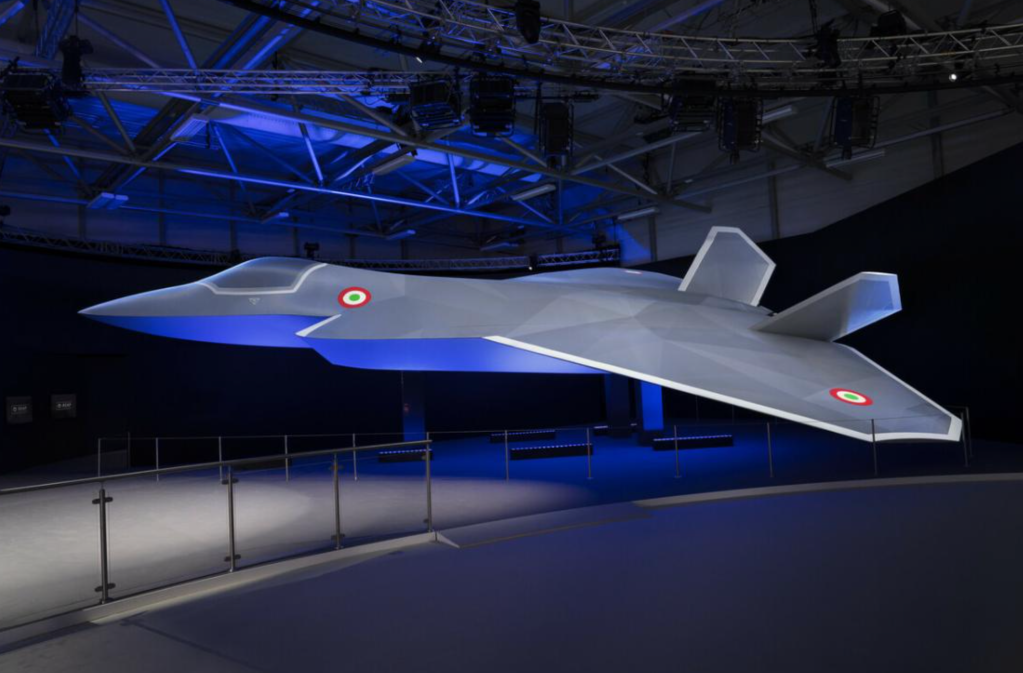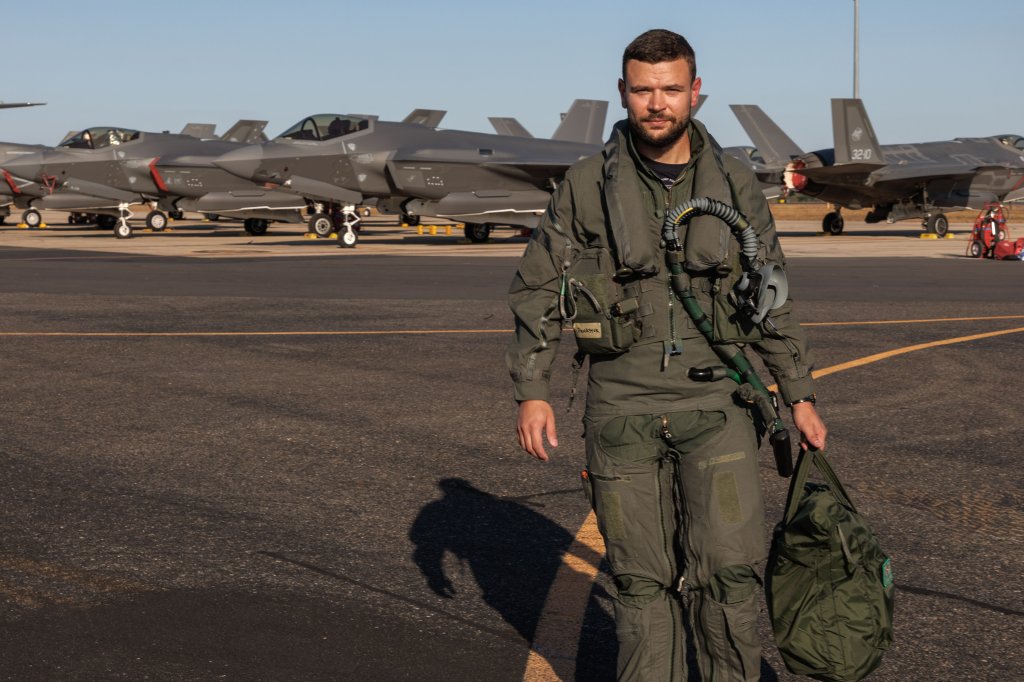The latest concept configuration for the tri-national next-generation Tempest fighter has been unveiled, with the revised design apparently being tailored for long-range performance combined with a significant payload capacity. The appearance of the new full-scale model comes amid growing questions about the future of the program, with the U.K. government poised to launch a major defense spending review that could significantly affect its fortunes.
The 1:1 scale model of the Tempest was among the highlights on the first trade day at the Farnborough International Airshow in England. In its latest configuration, the Tempest features a significantly larger wing, with a modified delta planform, strongly reminiscent of that found on the proposed F-16U — the original Block 70 version of this aircraft as pitched to the United Arab Emirates.

A bigger wing and the overall impressive size of the new Tempest concept suggest that the design is optimized — to a greater degree than it was before — for long range as well as a large payload. The additional internal capacity is presumably to accommodate both more fuel and a heavy weapons load. This should translate into a significant radius of action and/or loiter time as well as a generous ‘magazine’ capacity, to prosecute a large number of targets in the air and on the ground. The need for fighters to carry a larger load of (especially air-to-air) weapons — as well as weapons that are physically larger — has become more widely recognized of late and demands bigger airframes, especially when these payloads are to be carried internally, which is a basic requirement of stealth aircraft.
These kinds of considerations are also understood to be key drivers behind the design of the crewed fighter at the heart of the U.S. Air Force’s Next Generation Air Dominance (NGAD) air combat program.
As you can read about here, the Tempest concept has gone through several different iterations before today.
While the Tempest concepts have always involved a moderate-to-large size, the latest version appears to be the biggest yet.
All of the concepts have been based around an overall stealthy configuration, although significant modifications have been made to the wing planform. The original ‘lambda’ wing later gave way to a cropped delta with an arrow-like trailing edge. The trailing edge on the new concept is almost completely straight, as would be found on a classic delta. The wingtips, however, feature two cropped edges, akin to the F-16U.
Earlier iterations of the Tempest featured a characteristic ‘pelican’ nose profile, which was later replaced by a more conventional stealthy looking forward fuselage and engine intakes, which seems to share much more with the F-22 Raptor.
In the previous Tempest concept, the tail surfaces extended some distance aft of the wing trailing edge and appeared to comprise ruddervators, as found on the YF-23. The new concept instead has more conventional vertical stabilizers, with the delta wing’s trailing surfaces providing the primary source of pitch control. The enlarged wing on the new model means its trailing edge now extends beyond the rear of the tail surfaces. Both Tempest tail designs are something of a compromise in terms of low observability, with other sixth-generation fighter concepts doing away with vertical tail surfaces altogether.
The positioning of the new Tempest model means it’s hard to see the arrangement of the twin engines and their exhausts, although the engine nozzles appear to be well shrouded by the rear fuselage. The projecting ‘sting’ that was found between the engine nozzles on the first iterations of the concept model had already been removed.
Earlier concept models of the Tempest fighter, dating from around 2018 and from 2022:
Of course, this latest model is only a concept for the next-generation Tempest fighter, suggesting one possibility of how it may look in reality. It’s important not to read too much into the model at this stage, although it’s certainly been updated, which is itself of interest. These changes have also been incorporated as other partners have joined the program, namely Japan and Italy.
There’s also the fact that a demonstrator aircraft is planned, with the possibility that at least some of the changes in the different Tempest concepts may also be related to how this test aircraft will appear. Alternatively, it could be that the Flying Technology Demonstrator will be primarily concerned with proving subsystems for the Tempest, rather than its overall aerodynamic configuration.

The appearance of the new Tempest concept comes at what might turn out to be a critical juncture in the program.
First, it’s worth recalling that the Tempest crewed fighter is just one part of a much broader U.K. air combat initiative, the Future Combat Air System (FCAS) — one of two European efforts to use that same name. As well as the Tempest, the U.K.-led FCAS is planned to include uncrewed platforms, next-generation weapons, networks and data sharing, and more.
The Tempest fighter at the heart of the FCAS program also slots into an international collaborative program to field the aircraft, plus associated support and training, to the United Kingdom, Italy, and Japan. This effort is known as the Global Combat Air Program (GCAP). While the United Kingdom calls this fighter Tempest, the same name won’t necessarily be adopted by Italy and Japan.
While Italy’s Leonardo and Japan’s Mitsubishi Heavy Industries (MHI) are now involved in the Tempest via GCAP, alongside the U.K.’s BAE Systems, the fate of the entire program likely rests on decisions to be made by the British government.
With a new Labour government in power, FCAS and Tempest are coming under scrutiny, with a defense spending review scheduled.
There have already been concerns raised that a reassessment of defense spending priorities may cast doubt on these future air power efforts.

Last week, U.K. Minister for the Armed Forces Luke Pollard acknowledged that, while the Tempest project was “important,” he wasn’t able to make any firm commitments about its future until the new defense review.
“It’s not right for me to prejudge what might happen in the defense review,” Pollard said when asked about the program.
Whether simple prudence or otherwise, that apparent non-commitment has been compounded by Labour’s unwillingness to match the plans of the previous Conservative government to increase defense spending from around 2.2 percent of GDP to 2.5 percent by 2030. Labour has, however, said that it aims to reach the same target “as soon as resources allow that to happen.”
Of course, it’s still possible that Labour will commit to FCAS and Tempest and even stick to the previous government’s defense spending hike, although there are now reports that the U.K.’s defense industry is increasingly worried about the programs.
According to a report in The Telegraph newspaper, these concerns also now extend to Italy and Japan, which are said to have sought more information from the U.K. government on its plans for FCAS and Tempest — and, by extension, GCAP.

As we have discussed before, the program (more accurately now interwoven programs) are highly ambitious.
Launched in 2018, the Tempest program aims to get a new-generation crewed fighter into service by 2035. Plans for a supersonic crewed demonstrator aircraft that will feed into Tempest were first announced in July 2022, together with the aim of having it flying by 2027.
The British commitment to the Tempest program is already significant, with around 3,500 people in the United Kingdom already working on it and the expectation that this number will double in the years to come. The British government has earmarked around £2 billion ($2.6 billion) of funding for Tempest so far, although much more will be required.

Still, if the next U.K. defense review does downgrade the priority of FCAS and Tempest, that would certainly affect the current timelines (provided they are even achievable) and might cause one or both of the international partner countries to reconsider their own commitment to the program.
On the other hand, there’s the possibility that the forthcoming defense review will actually see an increase in funding for FCAS and Tempest.
Overseeing the review is Lord Robertson of Port Ellen, a former Labour defense secretary and secretary general of NATO. He has already stated that the review will focus on the modernization of the U.K. military to face the “deadly quartet” of threats emanating from China, Iran, North Korea, and Russia.
Any kind of major confrontation with China or Russia would demand high-end air power capabilities of the kind promised by FCAS and Tempest — provided they can be developed and fielded in time. In particular, a long-range platform of the kind hinted at by the latest concept model would seem to be tailored for future contingencies across the expanses of the Pacific. Japan, of course, will likely have very similar requirements, while Italy is also increasingly active in the Asia Pacific region, too.

Meanwhile, at Farnborough today, U.K. Prime Minister Sir Keir Starmer did move to allay fears around the future of FCAS and Tempest.
Again, he didn’t offer a guarantee that it would continue but said that it was “important” to Labour.
“It is an important program and I know that people in the room will want to hear me say that,” he said in response to a question about its future.
“It is a program on which we are making significant progress in my view and the defense secretary is holding a ministerial-level meeting I think next week in relation to this because of the significant benefits here in this country,” Starmer added.
Meanwhile, the U.K. Secretary of State for Business and Trade Jonathan Reynolds appeared to offer more reassurances on the project’s future.
“We see it as essential for the future, not just in terms of our defense needs but, obviously, our industrial needs,” Reynolds said.
Concerns over the future of sixth-generation air combat programs are not restricted to the United Kingdom, either.
The U.S. Air Force is also taking another look at its requirements for the crewed fighter element within the NGAD initiative. Here, the aim is to try and drive down the costs of the aircraft, each of which could have a price tag of almost $250 million. The end result may involve sacrificing certain capabilities, and the same could be the case for a post-defense-review Tempest program.
With the airshow continuing all week, there will likely be more news to follow about the Tempest and the wider FCAS effort. Certainly, the industry partners will now be making every effort to reinforce the importance of the programs at this critical juncture, with a growing feeling that the next U.K. defense review could determine whether the new-generation air combat program succeeds or not.
Contact the author: thomas@thewarzone.com

